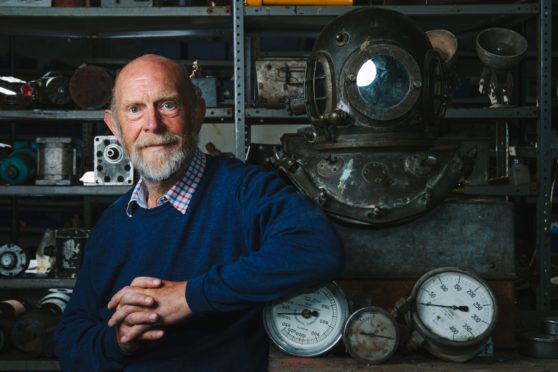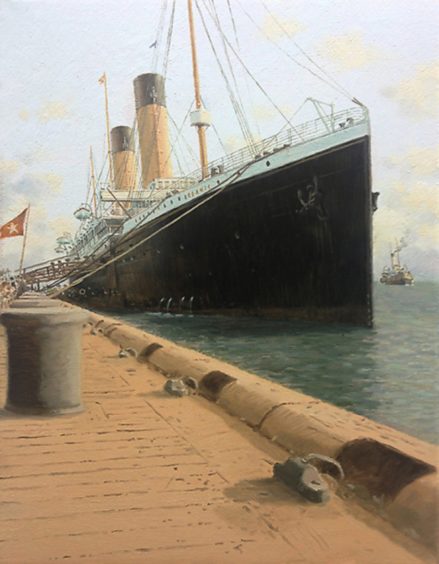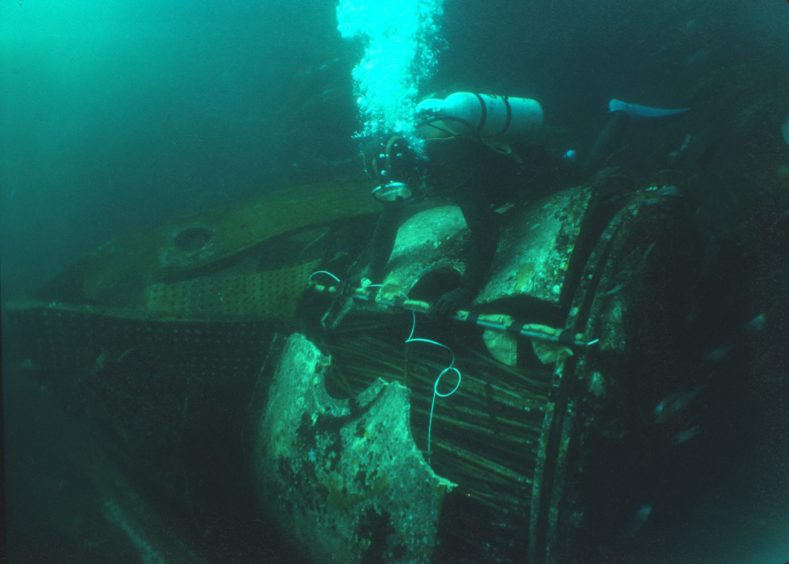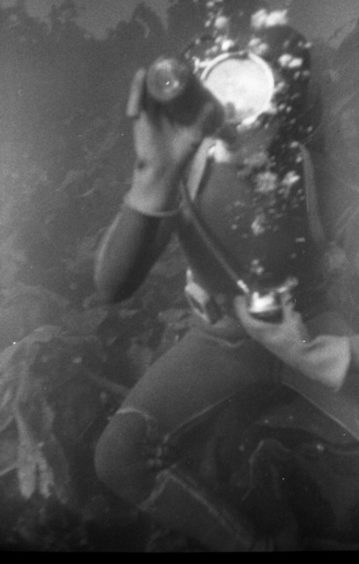
Deep below the waves, thousands of shipwrecks lie hidden on the ocean floor around Scotland, and diver Alec Crawford has made his fortune by hunting – and finding – their lost treasures.
The marine salvage expert has spent more than 50 years on and under the water as he plundered 74 of an estimated three million shipwrecks around the world for valuable scrap metal and missing cargo.
Whether diving among shallow wartime wrecks submerged off the Western Isles or remotely exploring a lost luxury liner 3,000 metres deep in the Mediterranean, Alec’s profitable hauls include precious gems, personal artefacts, gigantic brass propellers and even a few famous whisky bottles.
Yet Alec undertook his most memorable salvage mission in the formative years of his career off the uninhabited island of Foula, near Shetland. It was there Alec, then 23, and his diving partner Simon Martin discovered “an undiveable wreck”, the RMS Oceanic, one of the largest and most luxurious liners of its time. “For two young lads, it was a very lucrative haul and set us both up for life,” said Alec, who, now 72, can no longer take part in salvage missions at sea but has written about the shipwrecks that defined his early diving career in his first book, Treasure Island: True Tales Of A Shipwreck Hunter.
Alec grew up by the River Tay, a few miles from Balmerino, in Fife. He started fishing before learning to dive and jumped straight into his first salvage mission on the SS Salvestria deep in the Firth of Forth. From there he worked on previously explored sunken wartime vessels in the waters off Barra.
It was while working wrecks off the Fair Isle in 1973 that Alec and Simon learned of the White Star liner Oceanic that had sunk in 1914 after striking a reef called the Shaalds of Foula. Built in 1899, the Oceanic was once the largest ship in the world, rivalling the Titanic in terms of luxury until it was converted into an armed merchant carrier during the First World War.
Filled with youthful bravado and the prospect of a salvage haul of a lifetime, the two rookie divers set off for the tiny island with a makeshift salvage boat, minimal heavy lifting gear and modest funds. Aided by local fisherman, they found the wreck within days and began their remarkable salvage mission.
“When most people think of shipwrecks, they think of whole vessels but often these damaged ships lie in pieces on the ocean floor,” said Alec. “The Oceanic was thought to have slipped off the reef into deep water but the heavy tide had broken it up. Someone attempted to dive for the wreck in the 1930s but failed because the tides were too strong.
“I was drawn to salvage diving by the challenge, the commercial opportunity but also the idea you could be the first to discover a legendary wreck that nobody else could find. There’s a tremendous thrill of exploring these wrecks and not knowing what you are going to find.”
In their first hour of diving on the Oceanic, Alec and Simon picked up nearly half a tonne of copper and brass scattered across the seabed, which fetched about £500. The real treasure, though, lay in the ship’s engine-room components, miles of metal pipes, anchor and huge propellers.
Armed with underwater explosives and a bigger vessel with a mechanised winch, they dislodged the propellers shafts, hubs and two brass propellers, which weighed 29 tonnes each. “It was worth a lot of money,” recalls Alec. “Simon bought a nice flat in St Andrews at the time and one propeller would’ve bought him about three of those.
“We still have one of five spare propeller blades from the Oceanic on display in our yard. But, for me, the memories of the dive mean more than any item.”
The connections Alec forged with islanders in the decades he worked off the Scottish islands were equally meaningful. “It’s easy to get to know people well on the islands so we made some very good friends. A local from Shetland, John-Andrew Ratter, worked on the Oceanic with us and we are in touch to this day.”
Alec also met and married his wife and long-time business partner, Moya, on Foula. Originally from Lewis, she joined Alec, Simon and John-Andrew, as they continued to sweep the Oceanic debris.
During that time, they faced ownership disputes, lost ships to winter storms and required two emergency airlifts to hospital for Alec – when he surfaced too quickly and got “the bends” and when he was crushed by falling equipment on deck. Luckily, neither cut short his diving career.
“In the 1970s, risks weren’t assessed in the same way as today,” he recalled. “We had a lot more freedom. Dismantling these wrecks means inherent risks but there’s also a lot of pleasure and sense of achievement that outweighs it.”
Under British law, items found on shipwrecks are declared to the salvager of wreck, who must try to find its owner. If an owner is found, the salvager receives a “salvage award” according to the value of the goods.
When word spread of the valuable haul coming from the Oceanic, Shetland-based Hay & Co came forward to contest ownership of the wreck in court. Alec said: “We ended up paying them a very small percentage for everything we recovered, which was good because it wasn’t a lot of money from our point of view!”
Alec and Simon recovered 250 tonnes of valuable metal from the wreck over five years and hundreds of dives. The money they made from their salvage set them up for life.
Alec and Moya bought a farm in Fife and started a world-leading deep-sea salvage company, Deep Water Recovery and Exploration. They invented and developed pioneering technology and equipment to remotely locate and salvage wrecks at unprecedented depths.
This includes a record-breaking £1 million copper haul 1,250m underwater from a French cargo ship lost off the coast of Spain. They were the first to reach and recover precious gems and artefacts from the SS Persia, 3,000m down in the Mediterranean Sea.
“After Moya and I married we had this ambition to do deep-water salvage. The diving ended when we moved to working remotely with underwater cameras,” said Alec.
“It is very different way of exploring a wreck because you’re not physically or emotionally involved in the same way but you do cut out the dangerous aspects. I became more interested in the engineering side as we moved from physical risk to financial risk. The problem with deep-water salvage isn’t how deep you can go, but how you can do it cost-effectively, and the engineering is driven by that.”
Alec and Moya’s four children all spent time at sea with their parents and have gone on to work in different underwater engineering, diving and salvaging jobs.
After 50 years, Alec remains fascinated by the underwater world of marine salvage. Taking up writing has allowed him to delve deeper into how it all began with a few fateful dives off remote Scottish islands. “I still work in equipment design part-time but I can’t get a medical certificate to go to sea any more.
“But I’m fascinated about the future of deep-water salvage and I love writing about the past. Writing has allowed me to look back on everything we’ve achieved and describe it with a fresh perspective. The first book only goes up to 1977, so I don’t intend to stop any time soon.”
Treasure Islands: True Tales of a Shipwreck Hunter by Alec Crawford is published by Birlinn
Hangovers galore after famous bottle
Not all of Alec’s salvage missions have been for business and one memorable early dive, he recalls in his book, Treasure Islands, was in the Western Isles exploring the SS Politician, the famous shipwreck that inspired Whisky Galore.
The cargo vessel carrying 22,000 cases of whisky foundered off the coast of Eriskay in 1941, taking 264,000 whisky bottles down with it.
Last week, we told how a bottle from the famous wreck was going up for sale at auction but the highest bid, £6,000, did not meet the reserve price and the bottle is still on sale. Alec has two at home, sitting untouched on his mantelpiece, taken during his dive in the early 1970s.
“At the time, that dive was just a fun day out for us. We collected some loose scrap but just enough to pay for the fuel we used on the boat to get there,” he recalled.
“The receiver of the wreck, who lived on Barra, used to come out with us on our boat, the Dewy Rose. Funnily enough, he said the bottles were not worth the paperwork and gave us verbal permission for the dive.
“There was perfect visibility down there. We found some intact bottles in the corners of the hold and brought back about five each. At the time, they were valueless, so I kept one and gave the rest to family as mementoes.
“We actually drank one when we returned to Barra. We boiled the bottle, let it cool then and passed it around everyone. Worse medicine would be hard to find and the following morning was probably the worst I’ve had in my life!
“I’d never sell the bottles I’ve kept. These things are lovely to have because they are so unusual. They are almost ruined by being valuable.”

Enjoy the convenience of having The Sunday Post delivered as a digital ePaper straight to your smartphone, tablet or computer.
Subscribe for only £5.49 a month and enjoy all the benefits of the printed paper as a digital replica.
Subscribe

